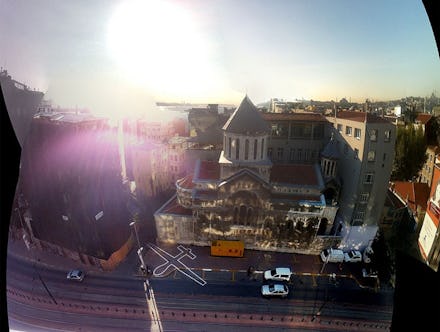These Haunting Drone Shadows Are Showing Up On City Streets. Here's Why.

The news: London-based artist and author James Bridle has created a street-art project that asks people to consider the increasing role that military drones are playing in our society — and in the lives of the people targeted by them.
To that end, he's created the Drone Shadow Handbook, a comprehensive set of instructions for placing life-size outlines of four military drones on city streets. The art project, which Bridle discusses in the below video, aims to raise awareness of and spark conversations about the use of unmanned aerial vehicles.
In Bridle's words, "So many of our technologies are so invisible, and we lack full understanding of what they do and how they affect our lives, which means that none of us really are capable of using them to their capacity, or understanding how they can be used against us." By placing 1:1 shadows of drones on civilian streets, Bridle is drawing attention to both the literal shadows that haunt foreign countrysides, and the pall that targeted killings have cast over our society.
The background: The Drone Shadows project isn't Bridle's first foray into visualizing America's long wars. He's also created a project called Dronestagram — Instagram, Tumblr, and Twitter accounts that provide a visual chronicle of drone strike locations as they occur — and a 7,000-page bound history of the Iraq War as recorded through changes to its Wikipedia article from 2004 to 2009. In October, Bridle gave a talk on his work at the Drones and Aerial Robotics Conference in New York City.
Military drones are a relatively recent phenomenon. American military surveillance drones didn't come to prominence until the Gulf War in the 1990s, and armed drones weren't in service until nearly a decade later, when they were deployed in the wake of 9/11 (the first reported killing by drone occurred in Afghanistan in November 2001). Bridle's Drone Shadows Handbook has scale diagrams of four of the most popular models used by the U.S. and UK: General Atomics' MQ-1 Predator and MQ-9 Reaper, Northrop Grumman’s RQ-4 Global Hawk, and Elbit Systems' Hermes 450.
Under President Barack Obama's first term, American military drone strikes in the Middle East increased at an alarming rate. While drone attacks peaked at one strike every five days in 2010, they continue to occur every 15 days on average, and reports of questionable civilian and child deaths continue to pour in. On Thursday, an American drone killed 11 members of a Yemeni wedding convoy, despite stricter guidelines imposed by Obama in May. In late November, the top U.S. commander in Afghanistan had to apologize for a strike that killed a child and wounded two women.
The takeaway: As we discuss the increasing use of drones in American airspace, Amazon's Prime Air and all, we should take time to consider the full technological capabilities of drones for both surveillance and strikes, and our government's current uses of the technology.
Drones certainly reduce the need for American soldiers to infiltrate remote and hostile areas. However, in addition to civilian deaths (the total remains unclear, but is likely in the hundreds or low thousands), drone bombings damage property, cause economic hardship, and traumatize and enrage survivors. The Stanford International Human Rights and Conflict Resolution Clinic points out that the looming threat of drones causes, "severe fear, anxiety, and stress, especially when taken together with the inability of those on the ground to ensure their own safety." The strikes are also traumatic for the young soldiers pulling the trigger. Describing the aftermath of his first strike to Der Spiegel, former Air Force pilot Brandon Bryant said, "I felt disconnected from humanity for almost a week." The article notes that he, "can't sit in one place for very long anymore, as it makes him nervous."
In his Drone Shadows Handbook, Bridle points out that drones, "remain largely invisible in part due to the manner of their operation, flying for long periods high in the atmosphere, and in part because the political motivations for their use prefer to remain obscure." His elegant Drone Shadows are a poignant reminder of the costs of a regime that we've come to accept as inevitable.